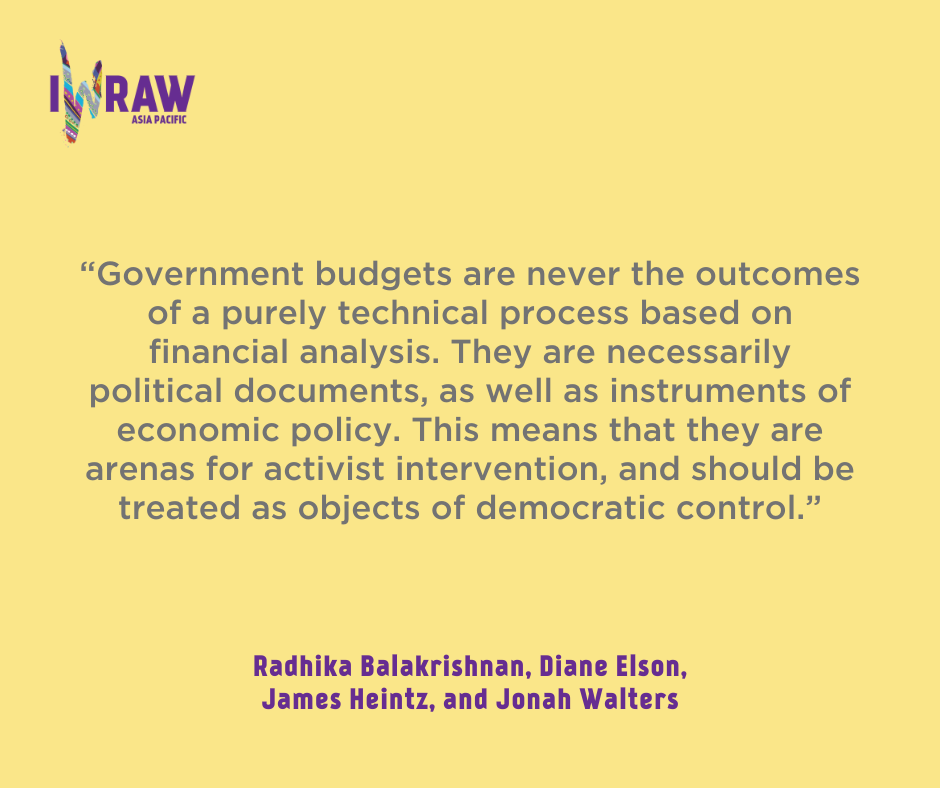 A just, green, feminist COVID-19 response and recovery
A just, green, feminist COVID-19 response and recovery  Further resources
Further resources
Exercises
Also available for download in .docx format.
A) This exercise will try to help you to think critically about some of the policy decisions on macroeconomics at the national level.
Try to find the national general budget of your country for the last two years. An internet search with keywords such as (in your national official language(s) and for relevant years), ‘2020 national general budget’, ‘national budget 2019 and 2020 comparison’, or ‘[Country] national budget 2020’, will most probably allow you to find them online.
- 1) Compare the overall budget between the two years; is there an increase or decrease in income and/or expenses?
- 2) Compare the total budgets of different ministries within a given year. This can give you an idea about the priority areas of the government for that year.
- 3) Compare the total budgets of different ministries in the two consecutive years. Which ministries had their budget increased, which ministries had their budget decreased?
- 4) When you look at the above analysis that you’ve made, what does it say to you about the changing priorities of the government in your country?
-
- a) What gender-specific effects could/would these changes have had among the population?
- b) Reflecting back on the last year, have you witnessed or read anything about the impact of these changes, especially related to the lives of women and girls? Have they been affected positively or negatively by these changes?
- c) Would these changes in the budgets of the ministries have differential effects among different groups of women (e.g. women from low-income households, women from different ethnic groups, women within different age groups, women employed in different sectors, etc.)?
B) Try to find a local, federal, or national effort for gender budgeting in your country. Analyse these gender-budgeting efforts by taking into account the issues that we’ve discussed within this starter kit, as well as your own research and ideas. Below are some questions which serve as examples into what you could look for in your analysis. The questions are suggestions to get you started in your analysis, rather than an exhaustive list.
-
-
- Is there enough available and accessible gender-disaggregated data to undertake informed gender-budgeting efforts? Do you think the gender budget you are examining takes the data into account in the policies it proposes?
- If gender budgeting has been implemented for more than three years, does data show any improvement on gender equality, or any reductions in the detrimental effects of the previous budgetary policies on women, girls, and non-binary people?
- Do you spot any issues that have not been addressed through this gender-budgeting effort?
- Have unpaid care work responsibilities been taken into account – both in calculations, and in solutions?
- Has there been any recognition of the interconnectedness of financial measures with any other issues, such as ecological and cultural?
- Has the gender-budgeting exercise taken an intersectional analysis into developing policies for different groups of women, girls, and non-binary people?
- Does any of this intersectional analysis overlap with the work that your organisation is undertaking?
- Do you observe any points in this gender-budgeting implementation that have aided (or may aid in the future) the work your organisation undertakes?
- Are you able to access any information on who formulated this gender budget? Who drafted its principles and policy recommendations? Are the people or the institutions representative of the population? How participatory was the process for the preparation of this budget?
- Who monitors the implementation of the gender budget? Who decides on how to adapt or amend it when needed?
- Is data readily available on the impacts and effects of these efforts on the everyday lives of women, girls, and non-binary people?
-
C) As the COVID-19 pandemic has spread throughout the world, many countries took macroeconomic measures to ease the effect of the pandemic on their economies and on their citizens. However, we’ve seen a wide array of measures and policies implemented with a large degree of different impacts on different parts of society. Please consider the below macroeconomic measures taken by some states and try to analyse them from a feminist perspective. Some questions that may help your analysis could be (and this list is by no means exhaustive):
- Who benefits from these policies, in the short term and in the long term?
- What effects could these policies have on the lives of women and girls?
- Could they result in intersectional discriminations for certain groups of women and girls?
- What could the short-term and longer-lasting effects of these policies be on the poverty experienced by women and girls, on the labour force participation of women, and on the participation of girls in education?
The below policies are real policies implemented by different states as a response to the crises exacerbated by the COVID-19 pandemic. More such policies can be found at the Feminist Response to COVID-19 website.
- State extends public social protections to foreigners in the country during the pandemic
- One day of the week has been declared as a public holiday, to keep people away from the roads and to facilitate sanitising of public transport
- State prohibits the firing of workers during the pandemic, both by public and for private institutions
- State provides urgent public services free of charge
- State gives subsidies, cash transfers, and tax reductions for small and micro-enterprises
- State extends unemployment benefits in duration
- Until 30 April 2020, all payments on income and VAT taxes, driving licence renewal fees, all bills on water and electricity, assessment taxes, and bank cheques are valued less than 200 USD
- State readjusts the national budget for 2021, allocating increased, low-interest loans from the government to individuals
- State provides subsidies and tax reductions for corporations with more than 250 employees
- State reduces the Value Added Tax on essential products and services sold
 A just, green, feminist COVID-19 response and recovery
A just, green, feminist COVID-19 response and recovery  Further resources
Further resources


